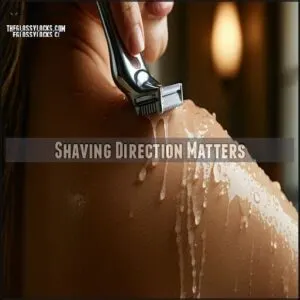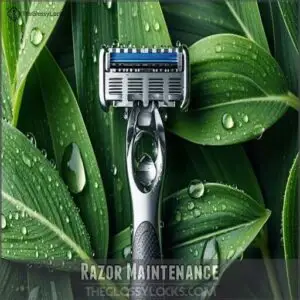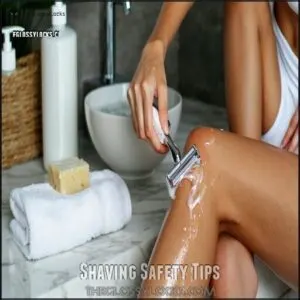This site is supported by our readers. We may earn a commission, at no cost to you, if you purchase through links.
 You’ll get better results with proper shaving preparation steps for women.
You’ll get better results with proper shaving preparation steps for women.
Start by soaking in warm water for 2-3 minutes to soften hair. Gently exfoliate to remove dead skin cells that can clog razors.
Apply a quality shaving gel or cream—never dry shave! Use a sharp, clean razor and shave in the direction of hair growth for sensitive areas.
Rinse with cool water to close pores, then apply alcohol-free moisturizer immediately. Don’t rush the process; those extra minutes prevent irritation and ingrown hairs.
The right preparation makes all the difference between just getting by and achieving that silky-smooth finish you’re after, with proper shaving techniques.
Table Of Contents
- Key Takeaways
- Pre Shave Preparation
- Choosing Right Razor
- Shaving Techniques
- Shaving Sensitive Areas
- Post Shave Care
- Razor Maintenance
- Alternative Hair Removal
- Shaving Safety Tips
- Skin Health Tips
- Frequently Asked Questions (FAQs)
- How do you prepare for a shave?
- How to get a clean shave?
- How do you shave after a section?
- How do you shave your body?
- What should I do if I Shave a lot?
- How do you shave without irritating your skin?
- How do I prepare my hair for shaving?
- What should I put on my face before shaving woman?
- How do you prepare your pubic area for shaving?
- What should I put on my body before shaving?
- Conclusion
Key Takeaways
- You’ll achieve smoother results by soaking in warm water for 2-3 minutes before shaving, as this softens hair follicles and opens pores for a closer shave.
- You’ll prevent irritation and ingrown hairs by exfoliating before shaving to remove dead skin cells that can clog your razor and create a barrier to smooth hair removal.
- You’ll protect your skin by always using a quality shaving gel or cream and shaving in the direction of hair growth first, especially in sensitive areas like the bikini line and underarms.
- You’ll maintain silky-smooth skin by applying alcohol-free moisturizer immediately after shaving and replacing your razor blades every 5-10 uses to ensure optimal sharpness.
Pre Shave Preparation
You’ll dramatically reduce skin irritation and achieve smoother results by taking a few minutes for proper pre-shave preparation.
Transform your shave from irritating to incredible with just three minutes of proper skin prep.
Soaking your skin in warm water for three minutes, gently exfoliating to remove dead skin cells, and cleansing with a mild wash creates the ideal foundation for a close, comfortable shave.
Soaking Skin Before Shaving
Stepping into a warm shower before shaving is your ticket to silky-smooth results.
Soaking your skin for at least three minutes helps:
- Water softens hair follicles, making them easier to cut
- Warm water therapy opens pores for a closer shave
- Skin hydration reduces friction and prevents irritation
- Proper prepping minimizes the chance of nicks and cuts
This simple preparation step transforms your shaving experience completely, leading to a more enjoyable and smooth shave.
Exfoliating Before Shaving
Now that your skin is warm and hydrated, it’s time for exfoliation. Removing dead skin cells before shaving lets your razor glide smoothly without catching.
Use a gentle exfoliating scrub or loofah in circular motions 2-3 times weekly. This simple skin prep step prevents ingrown hairs and gives you noticeably smoother results.
For sensitive areas, choose a milder formula and exfoliate with a lighter touch.
Cleaning Skin Before Shaving
Now that you’ve exfoliated, proper cleaning is your next step. Use a mild, hydrating cleanser to wash away exfoliation residue and surface oils.
A consistent pre-shave skincare routine is highly recommended.
The right cleanser won’t strip your skin’s natural moisture barrier. For best results, stick with lukewarm water—hot water can dry out your skin before you’ve even started shaving.
This gentle cleaning creates the perfect canvas for your razor to glide smoothly.
Choosing Right Razor
You’ll need a quality razor with sharp blades to prevent skin irritation and achieve a smoother shave.
The right razor fits comfortably in your hand and glides easily across your skin without pulling or tugging at hair.
Razor Blade Quality
The quality of your razor blade makes all the difference between a smooth shave and razor burn.
Using premium blades isn’t just luxury—it’s essential for protecting your skin.
Here’s what matters most:
- Blade sharpness (dull blades increase irritation by 70%)
- Blade material (stainless steel resists rust better than carbon steel)
- Blade count (5-blade razors provide maximum coverage)
- Cartridge lifespan (replace after 5-7 uses for peak performance)
Choosing the right womens razor is vital for a comfortable shaving experience.
Razor Handle Comfort
Beyond sharp blades, a comfortable handle makes all the difference in your shaving routine. The best razors for women feature ergonomic designs that fit naturally in your hand.
Matching your razor to your skin type is essential for a comfortable shave.
Look for grip styles with non-slip materials that won’t slide when wet. The balance point and weight distribution matter too—a well-balanced razor requires less pressure, reducing nicks.
Whether you choose disposable or reusable razor options, comfort prevents hand fatigue during those tricky areas.
Shaving Techniques
You’ll need to master proper shaving techniques to achieve silky smooth skin without irritation.
The direction you shave, the products you use, and the sharpness of your razor all work together to determine your results.
Shaving Direction Matters
The direction you move your razor can make or break your shaving experience. Always shave in the direction of hair growth first to prevent irritation and ingrown hairs.
Shave with the grain first—your skin will thank you with fewer bumps and smoother results.
Maintaining proper skin tension while applying minimal blade pressure guarantees a smooth result.
- Feel the liberating sensation of silky-smooth legs without the sting of razor burn
- Experience the confidence boost of perfectly shaved underarms that stay comfortable all day
- Enjoy the relief of a nick-free shaving session when you respect hair growth patterns
- Savor the satisfaction of mastering a technique that transforms your routine
Applying Shaving Gel
Consistently applying shaving gel creates a protective barrier that helps your razor glide effortlessly across your skin.
For ideal Skin Protection, spread a thick, even layer over the area you’ll shave. The gel maintains a Moisture Lock, preventing dryness during your shave.
If you don’t have shaving gel women’s products, try soap or conditioner as alternatives. Remember that glycerin-based gels work best for dry skin.
Choosing the right shaving cream products is essential for achieving silky smooth skin and preventing irritation.
Using Sharp Razor Blades
A dull blade creates more problems than it solves.
Your razor should glide effortlessly across your skin—when it doesn’t, it’s time for a replacement. Sharp razor blades reduce tugging, irritation, and razor burn while providing a closer shave.
Watch for signs of blade dullness: rough gliding, pulling sensation, or poor results. Multi-blade razors offer benefits but require regular replacement every 5-7 uses for ideal shaving preparation.
Shaving Sensitive Areas
When shaving sensitive areas like your underarms and bikini line, you’ll need to adjust your technique for the best results without irritation.
You can achieve smooth skin in these delicate zones by using gentle, short strokes and always shaving in the direction of hair growth first, which helps prevent irritation.
Shaving Underarms
Shaving underarms properly requires attention to hair growth patterns. Unlike legs, underarm hair grows in multiple directions, so you’ll need to shave in all directions for a smooth finish.
Apply generous shaving gel to minimize razor burn on this sensitive skin area.
Hold your arm up and slightly back to create a flat surface. Short, gentle strokes prevent nicks while ensuring thorough hair removal.
Shaving Bikini Area
The bikini area requires three key steps for a smooth shave without irritation. First, trim longer hairs before shaving to prevent razor clogging.
- Apply shaving gel generously to create a protective barrier
- Shave in the direction of hair growth first, then against for closeness
- Use short, gentle strokes to prevent razor bumps
- Exfoliate before shaving to reduce ingrown hairs
To achieve the best results, consider following a shaving guide for detailed instructions.
Shaving Legs
The legs are often easier to reach than the bikini area, but their larger surface demands proper technique.
You’ll want to shave lightly from ankles upward for the smoothest result.
The provided table outlines key leg shaving tips and their benefits, aiming to guide users through an effective shaving process.
Post Shave Care
You’ll need to give your freshly shaved skin proper attention to maintain that silky-smooth feeling.
Applying a fragrance-free moisturizer immediately after shaving helps lock in moisture and reduces irritation, preventing those pesky ingrown hairs that can ruin your perfect shave.
Applying Moisturizer
After tending to sensitive areas, your freshly shaved skin needs immediate attention.
Apply moisturizer within minutes after patting your skin dry to lock in hydration. Look for hydrating creams with ingredients like aloe or shea butter – they’re perfect for postshave care women often overlook.
Your skin will drink up the moisture, preventing that tight, dry feeling. Remember, consistent moisturizing creates a protective barrier, keeping your skin silky smooth all day.
Reducing Skin Irritation
Razor bumps and redness don’t need to be your post-shave reality.
To reduce skin irritation, wear loose, breathable cotton clothing immediately after shaving. Proper shaving techniques minimize irritation.
Apply cooling aloe vera gel or witch hazel for instant relief. For sensitive skin, try fragrance-free products with chamomile or oat extract.
Cold compresses work wonders too—just 5-10 minutes can calm angry skin and close pores effectively.
Preventing Ingrown Hairs
Battling ingrown hairs requires consistency in your routine.
Exfoliate regularly to prevent dead skin cells from trapping hair follicles.
Always wet skin thoroughly with warm water before shaving to soften hairs. Apply shaving gel to create a protective barrier, and shave in the direction of hair growth.
Rinse your razor between strokes to maintain a clean edge. Replace blades frequently to prevent razor bumps and maintain smooth skin texture.
Razor Maintenance
You’ll need to maintain your razor properly to guarantee smooth shaves and prevent skin irritation.
Proper cleaning, storage, and regular replacement of your razor blades are essential steps that directly impact the quality of your shave and the health of your skin, which is crucial for prevent skin irritation.
Cleaning Razor Blades
After moisturizing, don’t forget about your trusty razor. Keeping your blades clean prevents bacteria buildup that can cause skin infections.
- Rinse thoroughly after each use to remove hair and product residue
- Tap gently against a towel to remove excess water
- Never clean blades with brushes which can damage them
- Consider alcohol-based cleaning solutions for deeper sanitizing
Proper razor sanitizing extends blade life and prevents rust while ensuring your next shaving preparation is safe and effective. Regular use of Razor Cleaning solutions can also help maintain razor hygiene.
Storing Razor Properly
Once you’ve cleaned your razor blades, proper storage is your next defense against bacterial growth. Keep your razor in a dry place—never leave it sitting in shower puddles.
Blade care extends beyond just cleaning—dry placement guarantees your best razors won’t rust or harbor bacteria.
Completely dry environment
Replacing Razor Blades
Your razor will signal when it’s time for a change.
Replace blades every 5-10 shaves for ideal razor sharpness. Dull edges tug at hair, causing irritation.
You’ll notice when your disposable razor struggles to provide smooth results—it feels rough against skin.
Maintain your shaving routine by keeping fresh blades handy. Quality blade care prevents bacteria buildup, ensuring the best razors for women remain effective, with smooth results.
Alternative Hair Removal
You don’t need to limit yourself to razors in terms of achieving smooth, hair-free skin.
Waxing, depilatory creams, and laser treatments offer effective alternatives that can reduce hair regrowth and save you time in your beauty routine.
Waxing and Sugaring
In the context of hair removal options beyond shaving, waxing and sugaring stand out as popular alternatives.
These methods pull hair from the root for longer-lasting results than a razor.
- Waxing applies sticky resin with hair growth, removing against it
- Sugaring uses natural sugar paste applied against growth, removed with it
- Waxing may break hair follicles more frequently than sugaring
- Sugaring tends to cause less irritation for sensitive skin types
Depilatory Creams
Depilatory creams offer a painless alternative to your regular shaving routine. These hair dissolvers break down the protein structure in hair, allowing you to wipe away unwanted growth without razor burn.
Laser Hair Removal
While depilatory creams offer temporary solutions, laser hair removal provides a more lasting approach to hair reduction.
Unlike frequent shaving, this professional treatment targets hair follicles at the root.
- Costs range from $200-$500 per session based on treatment area
- Results typically require 6-8 sessions spaced 4-6 weeks apart
- Works best on darker hair against lighter skin types
- Reduces shaving frequency by up to 90% for many patients
Shaving Safety Tips
You’ll need essential safety techniques to transform your shaving routine from a potentially painful ordeal into a smooth, nick-free experience.
Proper lighting, sharp blades, and gentle technique work together to protect your skin while achieving that perfectly silky result.
Avoiding Cuts and Nicks
While traditional and at-home methods offer alternatives to razors, safety remains paramount when shaving.
To avoid cuts and nicks, always use a sharp blade with minimal pressure.
Shave in good lighting and rinse your razor frequently. Apply shaving gel generously and take your time – rushing leads to accidents.
Remember to bend knees for tricky areas and use short, gentle strokes around curves for superior skin protection.
Preventing Razor Burn
Razor burn can strike even the most careful shavers, leaving your sensitive skin red and irritated.
To prevent this common issue:
- Always use fresh blades to minimize friction
- Apply quality shaving cream formulated for sensitive skin
- Shave with light, gentle strokes in the direction of hair growth
- Apply soothing, alcohol-free aftercare products immediately after shaving to help calm the skin and reduce irritation, which can be a result of razor burn, making sensitive skin care crucial.
Shaving in Well Lit Area
With just the right light, you’ll dramatically reduce your risk of nicks and cuts.
Shaving in a well-lit area guarantees you can clearly see every contour and stubborn hair.
Natural daylight works best for razor visibility, but a bright bathroom light directly above you creates an illuminated space too. Clear views mean safer shaving, especially in sensitive areas where you can’t afford to miss spots.
Skin Health Tips
Your skin needs consistent care beyond just shaving to maintain its health and smoothness.
Regular moisturizing, exfoliation, and sun protection form the foundation of skin that’s both hair-free and truly radiant.
Using Sunscreen
Anyone who shaves should prioritize sun protection afterward.
Your freshly shaved skin becomes more vulnerable to UV damage, increasing skin cancer risk.
Apply a broad-spectrum sunscreen with SPF 30+ immediately after your shaving routine.
Wait at least 24 hours before extended sun exposure to prevent burns.
Choose a non-greasy formula that won’t clog pores or irritate your smooth skin.
Your future self will thank you for taking these precautions to ensure your skin remains healthy and protected with broad-spectrum care.
Exfoliating Regularly
Beyond sun protection, exfoliation creates the foundation for flawless shaving results.
You’ll want to exfoliate 2-3 times weekly to remove dead skin cells that can clog razors and cause bumps.
Grab a gentle scrub or loofah for improved skin texture and smoother shaving preparation.
Circular motions work best when prepping skin for shaving legs.
Remember, cell removal through regular exfoliation prevents those pesky ingrown hairs that no one wants.
Keeping Skin Hydrated
While exfoliation removes dead cells, hydration is what keeps your skin looking radiant.
Your skin’s moisture barrier needs constant attention, especially after shaving. Consider exploring dermatologist-recommended moisturizers for ideal hydration.
Try soaking your skin before shaving and apply a fragrance-free moisturizer immediately after. Hydrating products containing ceramides work wonders to lock in moisture.
For best results, use a hydrating cleanser daily and drink plenty of water—your skin literally drinks it up!
Frequently Asked Questions (FAQs)
How do you prepare for a shave?
Soak in warm water for three minutes, then exfoliate with a gentle scrub.
Apply a thick layer of shaving gel for protection.
You’ll reduce irritation and get a smoother shave every time.
How to get a clean shave?
Rinse with warm water to open pores.
Apply shaving gel evenly, shave with the grain using light pressure, rinse with cool water, and moisturize afterward.
Replace your razor regularly for best results.
How do you shave after a section?
Wait at least 6 weeks after a C-section before shaving.
When you’re cleared, use a fresh razor, warm water, and gentle shaving cream.
Take your time and don’t apply pressure to avoid irritating the scar.
How do you shave your body?
To tame your body’s natural flora, first prepare with warm water and exfoliate.
Apply shaving gel, use a sharp razor in the direction of hair growth, then finish with moisturizer to keep skin happy.
What should I do if I Shave a lot?
If you shave frequently, replace your razor every 5-7 uses, moisturize daily, and exfoliate 2-3 times weekly. Using quality shaving gel and giving your skin rest days can prevent irritation.
How do you shave without irritating your skin?
Thinking you can rush through shaving? Think again!
Soak skin in warm water for 3 minutes and exfoliate gently.
Apply thick shaving gel and use a sharp razor.
Moisturize afterward to prevent irritation.
How do I prepare my hair for shaving?
Soak in warm water for 3 minutes to hydrate skin.
Then, gently exfoliate with a loofah to remove dead skin cells.
Apply a thick layer of shaving gel for smooth razor gliding.
What should I put on my face before shaving woman?
Like a gentle shield for your delicate skin, soak your face in warm water.
Then apply a quality shaving cream or gel.
Exfoliate first to remove dead skin cells for a smoother glide.
How do you prepare your pubic area for shaving?
For best results, trim your pubic hair first.
Soak in warm water for 3 minutes, then gently exfoliate.
Apply a thick layer of shaving gel and shave in the direction of hair growth.
What should I put on my body before shaving?
You’ll want to start with warm water to soften hair.
Apply a thick layer of shaving gel or cream for protection against nicks and irritation.
Then exfoliate with a gentle scrub.
Conclusion
Mastering proper shaving preparation steps for women is like building a solid foundation for a house—essential for lasting results. You’ll transform your routine by following these nine secrets consistently.
Remember, rushing leads to irritation, while patience delivers that silky-smooth finish you’re craving.
Don’t underestimate soaking, exfoliating, and using quality products. Your skin deserves this care! When you prioritize these shaving preparation steps for women, you’re investing in both comfort and confidence.
- https://www.gillettevenus.com/en-us/womens-shaving-guide/how-to-shave/beginners-guide-to-shaving-prep/
- https://health.clevelandclinic.org/want-a-smooth-safe-shave-every-time-try-these-10-tips
- https://www.aad.org/public/everyday-care/skin-care-basics/hair/how-to-shave
- https://www.caretobeauty.com/body-shaving-tools/
- https://unsplash.com/photos/3gKTLEjffd4















